2008 VOLKSWAGEN JETTA steering
[x] Cancel search: steeringPage 303 of 477
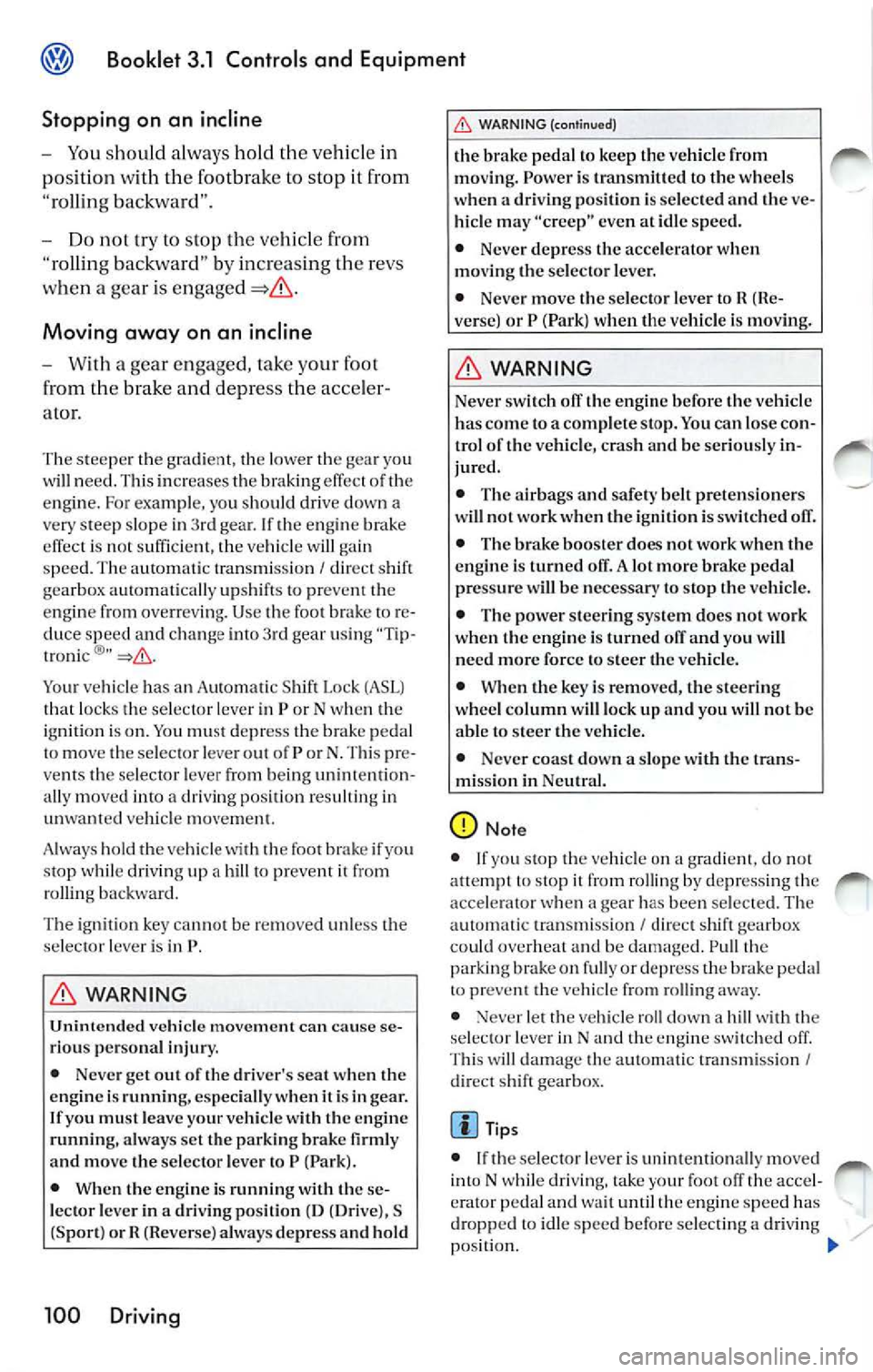
Booklet 3.1 Controls and Equipment
Stopping on an incline
- You should always hold the veh icle in
posit ion with th e footbrake to sto p it from
"ro lling backward".
- Do not try to stop th e veh ic le from
"ro lling backward" by increasing the revs
w hen a gear is
Moving away on an incline
- With a gear en gaged, rake your foot
from th e brake and depress t he accele r
a tor.
The steepe r the gradient, the lowe r the ge ar you
will need . This increases the brakin g effect of the
e n gin e. For exampl e, yo u should drive clown a
very steep s lo p e in 3rd gear. If the engin e brak e
effect is not suffi cient , th e ve hicle wi ll gain
speed. Th e auto matic transmi ssion
I direct shi ft
ge arbox automaticall y upshift s to prev ent the
e n gine from overr eving. U se the foot b rake to re
duce speed a nd chang e into 3rd gear using "T ip
tronic
Your veh icle has an A utomat ic Shift Lock (ASL )
t h at lo cks the sel ector lever in P or N when th e
ignition is o n. You mu st depr ess th e brake pedal
t o mov e the selec tor le ve r out of P or N. Thi s pre
ven ts the selector le ve r from b ein g unintention
a lly mov ed in to
driv ing pos ition resulting in
unwanted vehicl e movement.
A lway s hold the ve hicle
the foot if you
s top while driv ing up hill to preve nt from
rolling backward.
T he ignition ke y cannot be re m ov ed unl ess the
se lector le ver is in P.
WARNING
Unintended ca n ca use rious persona l inju ry .
• Neve r get out of the driver's seat when the
eng ine is runnin g, espe cially w hen it is in ge ar.
If yo u mu st lea ve yo ur vehicle w ith th e engine
runnin g, alwa ys se t the parki ng brake firml y
and m ove the se lec tor lever to P (Par k).
• When the en gine is runnin g wit h th ese
l ec tor lever in a driving po sition (D (Dr ive), S
(S port ) or R (Revers e) always de press and ho ld
100 Driving
WARN ING (continued)
the brake pedal lo keep the vehicl e from
mo vin g. Power is transmitted to th e wh eels
when a driving position is se lec ted a nd th e ve
hicl e m ay "creep" even a t idle spe ed.
• Neve r depr ess the acce lerato r w hen
mo vin g th e se lec tor leve r.
• Neve r move the selecto r leve r to R (Re
verse) or P (Park) when th e ve hicle i s moving.
WARNING
Neve r sw itch off the e ngi ne be fore the vehicle
ha s co me to a co mplete sto p. Y ou ca n lose co n
trol of the vehicle, crash and be se riou sly in
jured .
• Th e airbags and safe ty belt pr ete n sio ners
w ill not work when the ig niti on is sw itched
• Th e brak e booster does no t wor k w hen th e
e n gin e is turn ed oil A lot m ore brak e peda l
press ure w ill b e necessary to stop th e ve hicl e.
• The power steering system does not work
when t he eng ine is turn ed
and you w ill
ne ed more force to steer the vehicle.
• When th e key is removed, the s teer ing
w hee l co lumn will lock up and you w ill not be
able to stee r th e ve hicl e.
• Never co as t do wn a slo pe with the t rans
mi ssion in Neu tral.
Not e
• If you stop the ve hicl e on gradi ent, d o not
attempt to stop it rollin g by depres sin g th e
a cce le rat or wh en a gear has be en sel ec te d. Th e
a u tomatic tra nsmi ssio n
I direc t sh ift gearb ox
co uld ove rheat an d be damag ed . Pu ll th e
parking brake on fully or depr ess the brak e pedal
t o pr eve nt th e v ehicl e from
• :-lever let th e vehicle roll down a hill with the
s electo r lev er i n N and the engine swi tched off .
Thi s w ill dam age th e a utomati c tran smi ssion
I d ir ec t shift gearb ox.
Tip s
• If th e sele ctor l ev er is un intentiona lly mo ved
int o N whil e dr ivi ng, tak e your foot off the acce l
erato r peda l and wait unt il the eng ine s peed has
dropp ed to id le s peed b efo re se lectin g a drivi ng
po sition.
Page 308 of 477

Booklet 3.1 Controls and Equipment
Parking
The parking brake can be us ed to pr eve nt the vehicle from moving uninten tion
ally.
A lways apply th e parking brake fully when
yo u leave y our vehicl e a nd when you p ark
yo ur vehicl e.
- Use the foo t brake to stop the veh icle.
- Appl y th e parking brake full y.
- On a ma nual tran smi ssion engage
gea r. On a n aut omatic tra nsmi ssion move
the selector lever to P.
- Switch off the engine and r emo ve the
key from the ignition lock. Turn th e
s tee rin g w he el s li ghtl y to en gage the
stee ring loc k.
- Always take you ve hicle keys w ith you
whe n yo u leave the
When parking on slopes
Before turnin g off the engin e, turn the steer ing
w hee l so if th e vehicle sta rt s to ro ll, it will roll
i nt o th e c urb:
• If th e ve hicle is faci ng
turn the whee ls so that they poilll toward the cur b.
• If th e vehicle is faci ng
turn the front
w heels so t hat they poi nt away from the curb .
• As a lways, appl y th e pa rking
full y and
m ove the se lector lever to P.
WARNING
Improp er parking procedures can lead to se
ri ous perso nal injury for you or your passen
gers.
• Never remove the key from steering lock
whil e th e ve hicle is movin g or rollin g to a stop .
The steer ing wheel
will lock up and you will not be able to stee r or control the vehicle.
WARNING
• Never park where the hot exha ust sys te m
co uld ignit e flammabl e material s, such as
bru sh, l eave s, dry grass, sp illed fuel etc.
• Alw ays apply the parking brak e fuJly wh en
parking your vehicle.
• Never leave anyone in your vehicl e to pre
ven t the ve hicle from moving if the parking
br ake is r elease d or selector lever is moved.
• Alwa ys tak e the key w ith you when you
l e ave the vehicle. The engine can be started
and vehicl e sy stems su ch as the power win
d ows can be operated leading to seriou s per
s onal injury .
• Never leave children , disabl ed p erson s or
anyone who cannot help th emselves in the ve
hicl e. The doors can b e lock ed u sing th e re
mot e co ntrol trappin g passenger s in the ve
hicle in an emergenc y. Depending on the time
of year, people tr app ed in
vehicle can be
expose d to v ery high or very low temperatures.
Note
• Please exercise care when yo u pa rk your ve
hicl e in parkin g are as w ith p arkin g barri ers or
cu rb s. Parking barriers and curb s vary in heig ht
an d co uld damage yo ur bump er and re la te d
compo nents as th e fron t of yo ur vehicl e moves
over
b arri er or curb that is too high . as you park
or as you back out of parking spot. In order to
be sur e th at no su ch d ama ge ca n occ ur, yo u m ay
wish to s top sh or t o f h av ing th e front tires o f yo ur
ca r touc h parking barri er o r curb.
• Please a lso exe rcise exce ptiona l ca re when
yo u drive up or d own steep ramp s or drive over
cu rbs or oth er obsta cles, fo r w hi ch lhe ve hicle is
not d esign ed , b ec au se compone nts of th e ve
hicl e close lo th e groun d su ch as bump er cove rs,
s poil ers , suspensio n and exhaust syste m com
ponent s, m ay beco me
Driving 105
Page 311 of 477
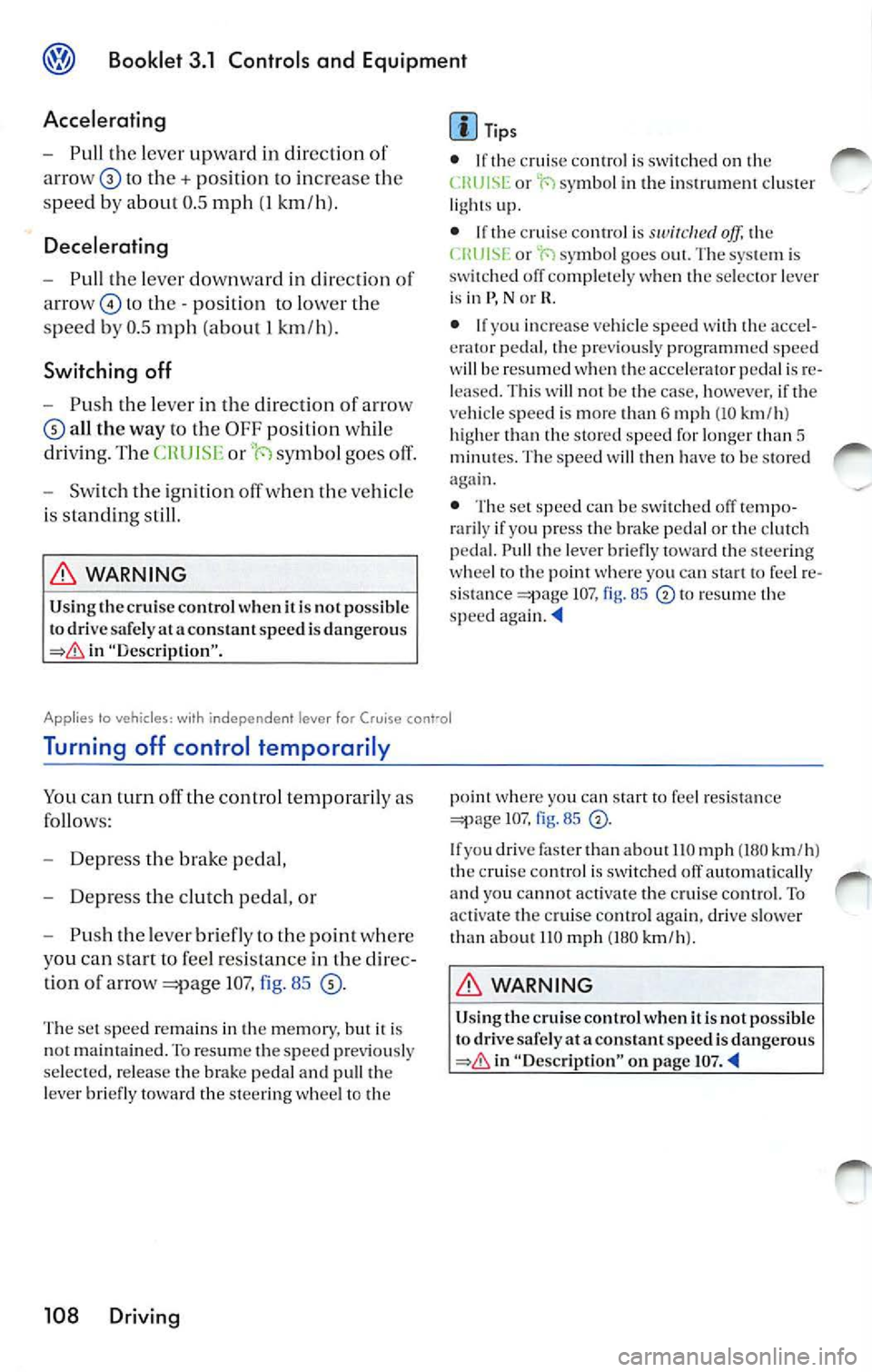
Booklet 3.1 Controls and Equ ipment
Accelerating
- Pull th e lever upward in direction
to th e+ position to increase the
s peed by about 0.5 mph
(I km/h ).
Decelerating
- Pull the lever downward in direction of
a rrow © to the - positio n to lowe r the
s peed b y 0.5 mph (about I km/h).
Switching off
-Push the leve r in the direction of arrow
all the way to the OFF position whil e
d rivi ng. The CHU ISE or
symbo l goes off .
- Sw itch th e ignit ion off when the v ehicle
i s standing still.
WARNING
Using the crui se cont ro l whe n it i s not possib le
to dri ve sa fely at a constant speed is dangerous
in "Desc ription".
Tip s
• If th e cruise con trol is switc hed on th e
( or ·t-i sy mbol in the in stru ment cluster
li g ht s up .
• If th e c ruise co ntrol i s
the or symb ol goes o ut. The syste m is
swi tc h ed off compl etely when the selec tor leve r
is in P, Nor
• If yo u increase vehicl e speed with th e accel
erato r pedal, the prev ious ly programmed sp eed
will be re sum ed when the acce le rator p edal is re
leased . T hi s w ill not be the case. however, ifche
vehicle s peed is mo re than 6 mph (10 km/h)
hi gh er than the s tored speed fo r long er
5
minut es. The speed will then have to be store d
again .
• The set speed can be sw itche d off te mpo
rarily if you p ress the brake peda l or the clutch
pedal. Pull th e lever briefly towa rd th e steering
whee l to the point where you can start to fee l re
s is tance
107, fig. 85 to r esum e the
speed again. "'4
App lies to vehic les: with independent lever for Cruise cont·ol
Turning off control temporarily
You can turn off the control temporar ily as
follow s:
- Depress the brake pedal,
- Dep re ss th e clutch pedal, or
- Pu sh the l ever briefly to the point where
yo u can star t to feel r esis tanc e in the dir ec
t ion of a rrow
10 7, 85
Th e set sp ee d re mains in th e mem ory , but it is
not maintain ed. To res um e the spee d previo usly
se lected, re lease the brak e pedal and pull th e
l e ver bri efly coward the stee ring wheel to the
108 Driving
point whe re yo u ca n start to f eel resi stan ce 107, fig. 85
If you drive faster than about 1 10 mph (180 km/h)
the cru ise co ntrol is sw itch ed off automati cally
a nd you cann ot ac tivate the cruise contro l. To
ac tivate the cru ise control again, drive s lower
than about 110 mph (180 km/ h).
WARNING
Us ing the cruise contro l when it is not possib le
to drive safely at a constant spee d is dangerous
in "Descrip tion" on page 107. "'4
Page 313 of 477
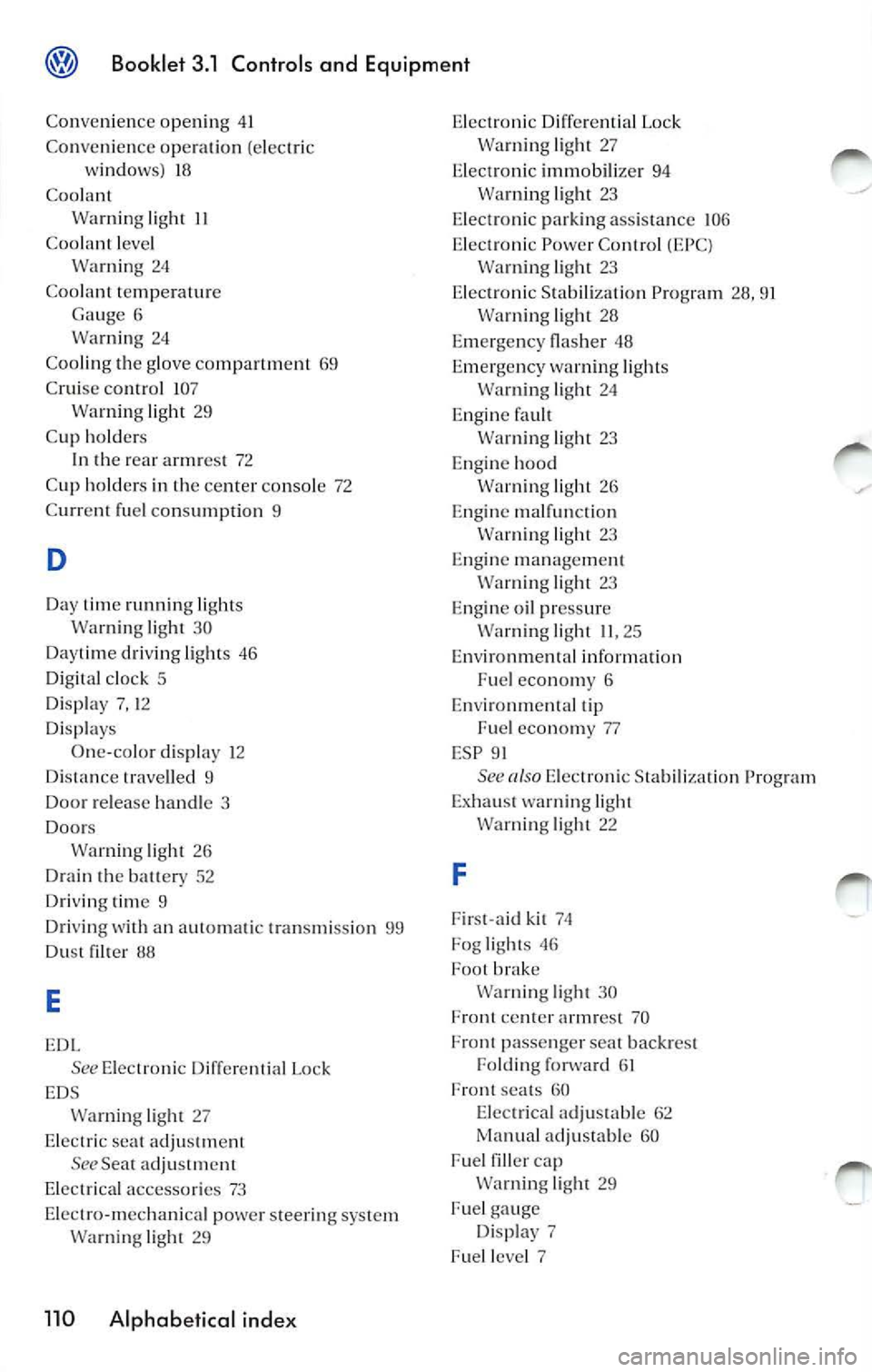
Booklet 3.1 Controls and Equipment
Conve nien ce open ing 41
Conven ie n ce operatio n (elec tric
w ind ows) 18
Coo lant
li ght 11
Coo lant leve l
Warn ing 24
Coo lant te mperature
Gauge 6
Warn ing 24
Coo ling the glo ve
69
C ru ise co111rol 107
Wa rnin g light 29
Cup ho ld ers
I n the rear armrest 72
C up holder s in the center co nso le 72
C urrent f uel cons umption 9
D
Day time runnin g lights
Warning lig ht 30
Daytime dri vin g ligh ts 46
Di gita l c loc k 5
Di sp lay 7, 12
D is plays
One-co lo r display 12
Distance trave lled 9
Door re lease hand le 3
Door s
Wa rnin g lig ht 26
Drain the bauery 52
Driving time 9
Driving
an automatic transmi ssion 99
Dust
88
E
See Electron ic D iffe rentia l Lock
EDS
Wa rnin g light 27
E lec tric seal a djustment
See Seat adj ustme nt
Ele ctrical accessories 73
Elec tro-mechanica l power steering syste m
Warning light 29
110 Alphabetical index
Electron ic Diffe re nti al Lock
Wa rnin g lig ht 27
Electronic immobilize r 94
Wa rnin g light 23
Electro nic parking assistance 106
E lectro nic Power Control (EPC)
light 23
E lec tron ic Stabi liza tion Program 28, 91
Wa rnin g lig ht 28
Emergency
48
E m erge ncy wa rning lights
light 24
Engi ne fault
Warning light 23
E ngin e hood
Warning light 26
E ngin e malfun ction
Warn in g light 23
E ngine mana gement
Warn ing lig ht 23
E ngine oil pr essure
Wa rnin g light 11 , 25
Environmental inform ation
Fuel economy 6
Environmental tip
Fue l economy 77
ESP 91
See E lectronic Stabil ization Program
Exhau st warning light
Warning lig ht 22
F
Firs t- aid kit 74
Fog lig ht s 46
Foo t brak e
Wa rning lig ht 30
cen te r a rmr est 70
Fron t passenger
backre st
Folding forward 6 1
F ront seats 60
E le ctri ca l adj ustab le 62
Manua l ad justab le 60
Fuel filler cap Wa rnin g light 29
Fue l g auge
Di splay 7
Fuel level 7
Page 324 of 477
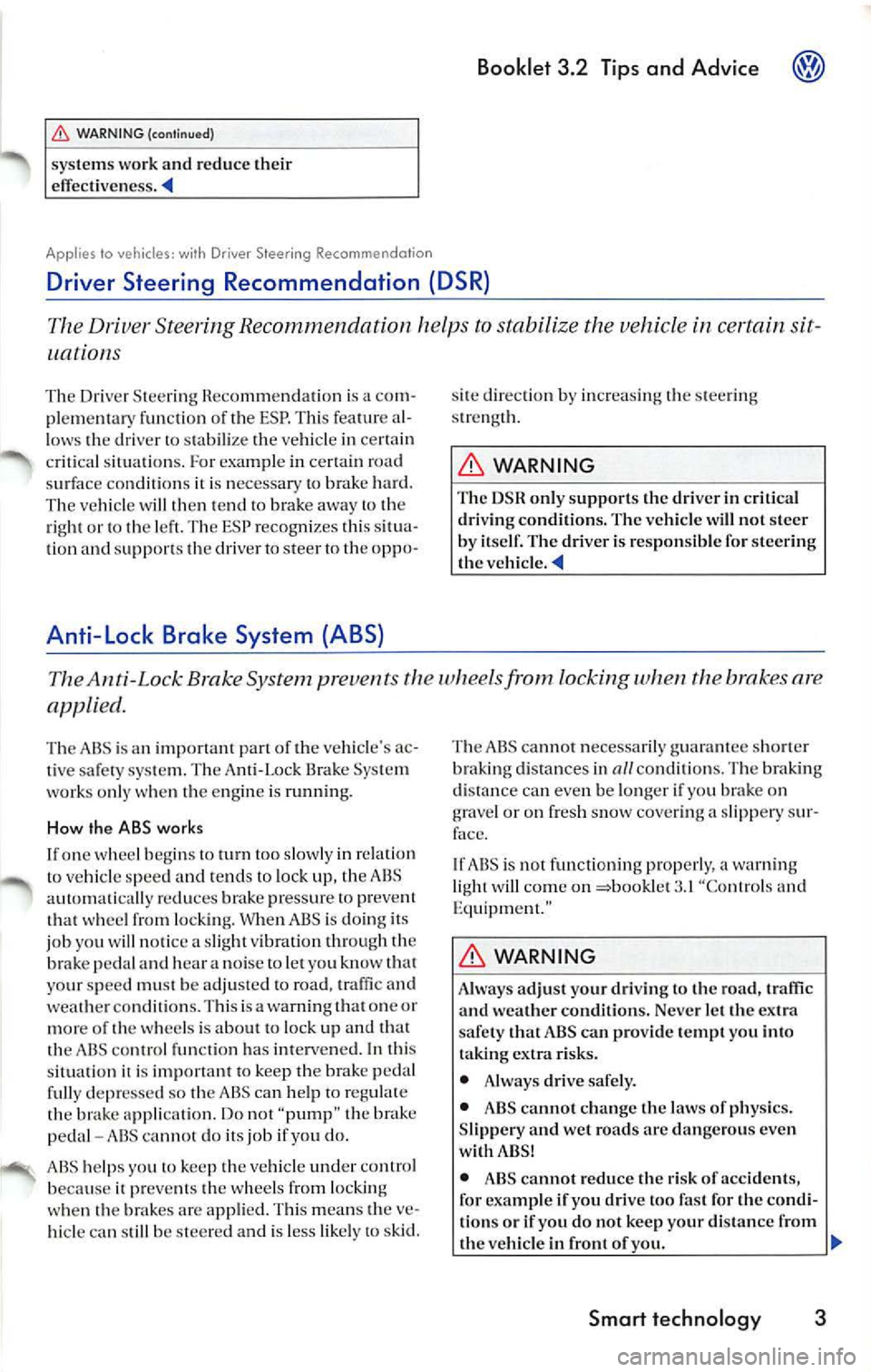
WARNING (continued)
systems work and reduce their
effect iveness.
Applies to vehicles: with Driver Steering Recommenda tion
Booklet 3 .2 Tips and Advice
Driver Steering Recommendation helps to the vehicle in certain sit
uations
The Driver Stee ring R ecomm endation i s a com
pl em entar y function of the ESP. This fea ture al
low s th e driv er
stabilize ve hicl e in certain
critical situati ons. Fo r example in certai n road
s ur face conditi ons ii is necessary to brake hard.
The vehicl e will then te nd to brak e awa y to the
r ig ht or t o 1h e lef t. Th e ESP reco gnizes this situ a
tion and supp ort s the drive r to steer to the oppo-
Anti -Lock Brake System {ABS)
sit e dire cti on by in crea sing th e stee rin g
s tr ength.
WARNING
The DSH only supports the driver in cri tical
dri vin g co ndition s. The ve hicl e will not s teer
by itse lf. The dr ive r is res pon sible fo r steering
the vehicle .
The Anti-Lock Brake System prevent s th e wheels from locking when the brakes are
applied.
Th e ABS is an important part of the vehicle 's ac
ti ve safety system. The Anti-Lo ck Brake Syste m
work s onl y when the en gine is run ning.
How the ABS works
If one w he el begi ns tu t urn too s low ly in r elat io n
t o ve hicl e speed an d le n ds to lock up, t he ABS
a utom ati ca ll y
brak e pres sur e lO preve nt
that whee l fr om locking. When ABS is do ing it s
job you will notice a sli ght vibrati on throu gh the
brake pedal and hea r a noise to l et yo u know tha t
yo ur speed must be adjuste d to road, traffic and
wea ther condi tion s. T his is a warn ing 1hat on e or
mor e of the whee ls is about to lock up and that
th e AB S co ntr ol function has inter vened . In thi s
s ituati on
is important to keep the brak e peda l
fully depr essed so the ABS can help to re gul ate
th e brake applica tion. Do not "pump " th e
peda l -ABS can not do its jo b if you do.
A BS helps you 10 kee p th e ve hicl e und er control
be cause i t prev ent s th e w hee ls from locking
w hen th e brak es arc ap plied. Th is m ean s th e ve
hicl e ca n still be s teer ed and is less likely
on
g rav el o r on fresh sno w cover in g a slipp ery sur
If AB S is not functioning properl y, a wa rnin g
li ght will co me on 3.1 "Co n1rol s and
E quipm ent. "
WARNING
Always ad just yo ur dri vin g to the road, traffic
and weather conditio ns. Neve r le t th e ex tra
s afe ty that ABS can provide te mpt you into
taking extra risks.
• Always drive safely .
• ABS canno t ch ange the
of ph ysics.
S lipp ery and wet roads are dangerou s ev en
wi th ABS!
• ABS ca nnot reduce th e risk of accide nts,
f or examp le if yo u drive too
for the co ndi
ti ons or if you do not keep your distance from
th e vehicle in front of you.
Smart technology 3
Page 327 of 477

Booklet 3.2 T ips a nd Advice
Power steering
011 vehicles with pow er stee ring , th e of power ass ista nee is regu lated e lec
t roni call y acco rdi ng to vehicle speed, stee rin g wheel torque and stee rin g w hee l
angle.
Th e power assis tance prov ided in the power
s te erin g sys te m is not hydrau lic, but m e
c h ani ca l usin g an elec tric mot or. The adva n
t a ge s of this steer ing system includ e th e fact th at
n o hydra ulic co mponents such as hoses, o il co n
t a in ers ,
o r fl uid s are re quired.
Fu rth ermo re , t his is co nsiderable de crease in
e n ergy req uir e d . T he e lec trome chani ca l s tee rin g
sys te m . in contras t to th e hydrau lic sys te m
(w hich re qu ires a co nstant flo w of fluid ), only
co nsume s energy when th e ve hicle is actua lly
be ing stee re d.
T he fu el consump tio n i s re du ced as a res ult.
If th e electro mec han ica l p owe r stee ring sys te m
fa ils, the pow er a ssis ted stee ring system
w ill still
work. If th e engin e is sw itch ed off, the pow er s
teer ing does no t fun ctio n and th e steer ing
wh eel is ve ry hard t o tu m .
WAR NING
Turning th e s teer ing whe el is very w hen t he power s tee rin g sys tem is n ot
work ing and it is harder to co ntrol the veh icl e.
• Neve r le t t he veh icle coast with th e engine
swit ch ed off.
Do no t kee p th e steer ing wheel turned all the 10 left or righ t fo r m ore than 15 seco nds
w hen th e e ngin e is runnin g. Doin g so co uld
damag e th e powe r steer ing
Data
H eco rder (EDH ), in sta lled by so me manufa c
tur ers
the exp ress purpo se of ca pturing data
fo r retr ieva l aft er an acci den t or cra sh eve nt.
are so metimes called "cras h recorders".
So me s tat e laws res tr ict t he re tri eva l or down
loadin g of da ta sto re d by ED
that were in
s ta lled in a vehicle for the exp ress p urpose of re
tr iev ing dat a af te r an acc ident or crash event
wit hou t th e Owner's conse nt.
your vehicl e is not equipped with an it is equipp ed with number of e lec tro nic
contro l modu les for variou s vehicle sys te m s
s u ch as, fo r ex am ple . e ngine function, em iss io n
6 Smart t echno logy
co ntrol, as we ll as fo r th e airbags and safe ty
be lts.
The se elec tronic con trol mod ules also
ve
hi cle-re late d dat a dur in g nor mal ve hicle ope ra
ti on for diag nos tic and re pair purp oses. The re
cordi ng capaci ty of the e lec tron ic co ntro l mod
ul es is limit ed to data (n o so und is record ed ) a nd
on ly a small amo unt of data is ac tually reco rde d
ove r a very limited p eriod of tim e and stor ed
a sys te m fau lt or o th er co ndition is se nse d by co ntro l un it. So me of dat a th en sto red
m ay re late to ve hicle sp ee d, direc tion, braking as
well a s res traint system use and performan ce in
th e eve nt of a cra sh or o th er conditi on. S to red
c an only be rea d and downloade d wit h spe
cia l
Page 373 of 477
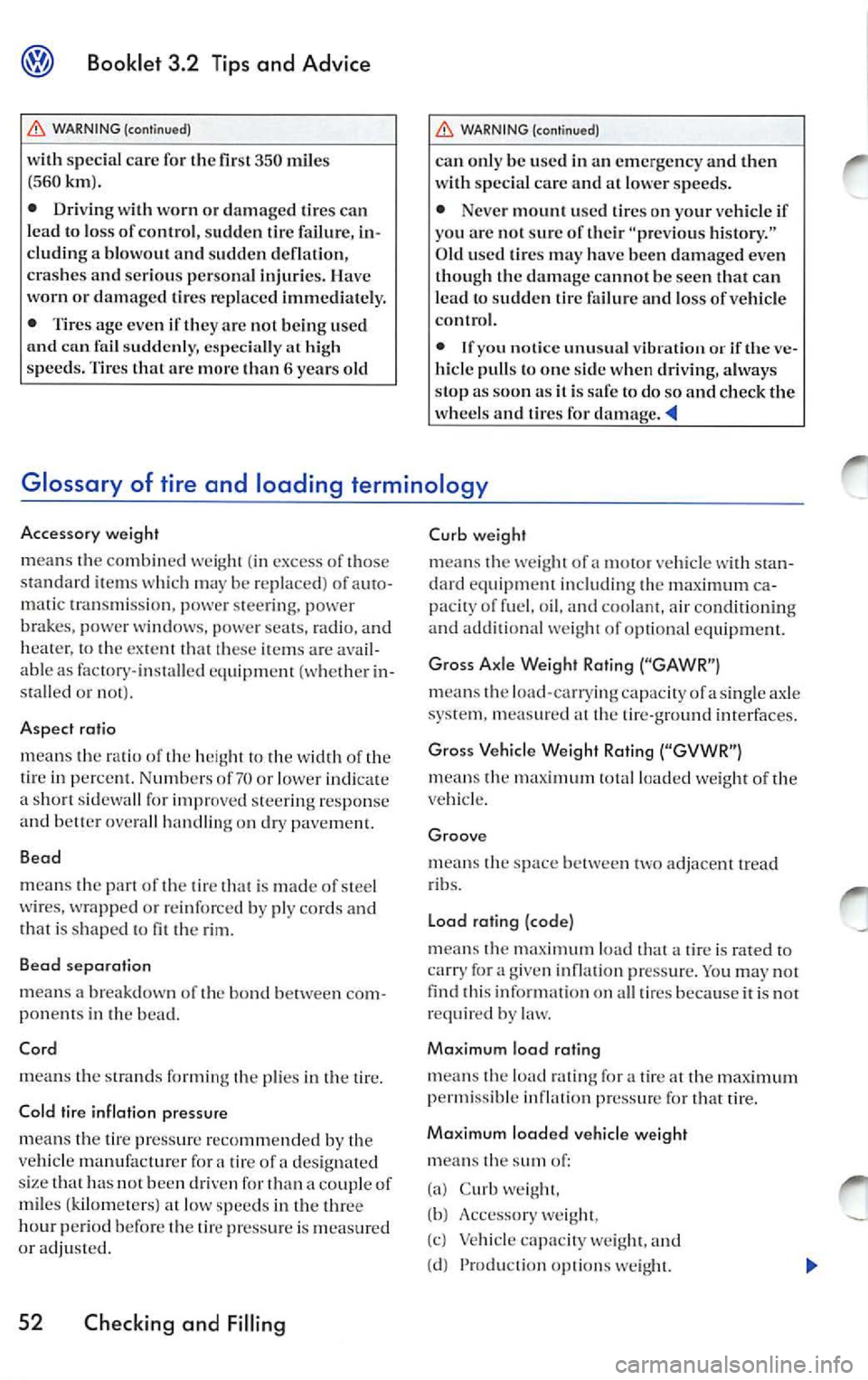
Booklet 3.2 Tips and Advice
WARNING (continued)
with special care for the fir st 35 0 mile s
( 560km ).
• Driving with worn or dam aged tires can
l ead to los s of co ntrol, sud den tire failure, in
clud ing a blowout and sudden deflation,
cras hes and se riou s perso nal injurie s. H ave
worn or damaged tires rep laced immediat ely.
• Tires age even if th ey arc not bein g used
a n d can fail sudd enl y, es pecia lly
at high
s p ee ds. Tire s th at ar c mor e than 6 yea rs old
WARNIN G (contin ued)
ca n onl y be use d in an em erge ncy and then
w ith specia l ca re and at lo w er sp eeds.
• Neve r m ount u sed t ires on yo ur vehicl e if
you arc not s ure of th eir "pre vio us hi story."
Old use d tir es ma y have been dama ged eve n
t h ough th e damage cann ot b e see n that can
l ea d to sudd en tir e fa ilur e and loss of vehicle
contro l.
• If yo u notice unu sual vibrat ion or if th e ve
hicle pull s to one sid e wh en drivin g, a lways
stop as soo n as it is safe to do so and check the
wheels and tires for dam age.
Glossary of tire and loading terminology
Accessor y weight
m ea ns th e comb ined weigh t (in excess of those
s tand ard item s wh ic h may b e re p laced ) of auto
matic tran sm iss ion, powe r stee ring . power
brake s, pow er wind ows, powe r se ats. radio, a nd
heat er, to th e ex tent that th ese item s are ava il
ab le as factory- in st all ed eq ui pment (w heth er in
s talled or not).
Aspect ratio m ea ns th e ra tio of th e heig h t
th e wid th of th e
ti re in perce nt. Numbers of70 or lowe r ind icat e
a sh ort sid ewa ll for imp roved steering r espons e
a nd be tter ove rall hand ling d ry pa vement.
B ead
m ea ns th e pan oft he tire that is m ade of stee l
w ires, wrapp ed or reinfor ced by ply cords and
t h at is s hape d to
th e rim .
B ead separation
mean s a breakdow n of th e bo nd b etwee n com
p on ent s in the bea d.
Cord mea ns th e s trands for ming the plies in t he tire .
Cold lir e inflation pressure
m ea ns th e tire press ure reco mmend ed by the
ve hicl e m anu factur er f or a tire of a des ig nate d
s ize th a t ha s not b ee n d rive n for th an a co up le of
m iles ( kilomete rs) at low sp eeds in th e thr ee
h our peri od befo re th e tire press ure is m eas ured
or ad juste d.
52 Checking and Filling
Curb weig ht
mea ns th e weig ht of
a moto r ve hicle sta n
dard equipm ent in cluding th e maxi mum ca
paci ty o f fuel. oil. a nd coolant, air co ndition ing
and additional weight of o ptional equipme nt.
Gr oss Axle Weight Roting
m ea ns th e load -ca rryi ng ca pacity of a sin gle axle
sys tem, measured at th e tire-gro und in te rface s.
Gro ss Vehicl e W eight Roling
means th e max imum t otal load ed weig ht of the
ve hicl e.
Groo ve
m ea ns th e spa ce betw een
ad jacent tread
r ib s.
L o ad rotin g (cod e)
m eans the maximum load that
tir e is ra ted to
carry for a given inflation press ure. You may not
this o n all tir es bec ause it is not
required by law.
Ma ximum load roting
m ean s th e load rating for
tire at th e perm iss ible inflatio n pressu re for that t ir e .
Ma ximum load ed ve hicle weig ht
mean s th e
of:
(a) C urb weig ht,
( b ) Accesso ry weight,
( c ) Vehicle capa city weigh t, a nd
(cl ) Pro duction o ptions we ig h t.
Page 381 of 477
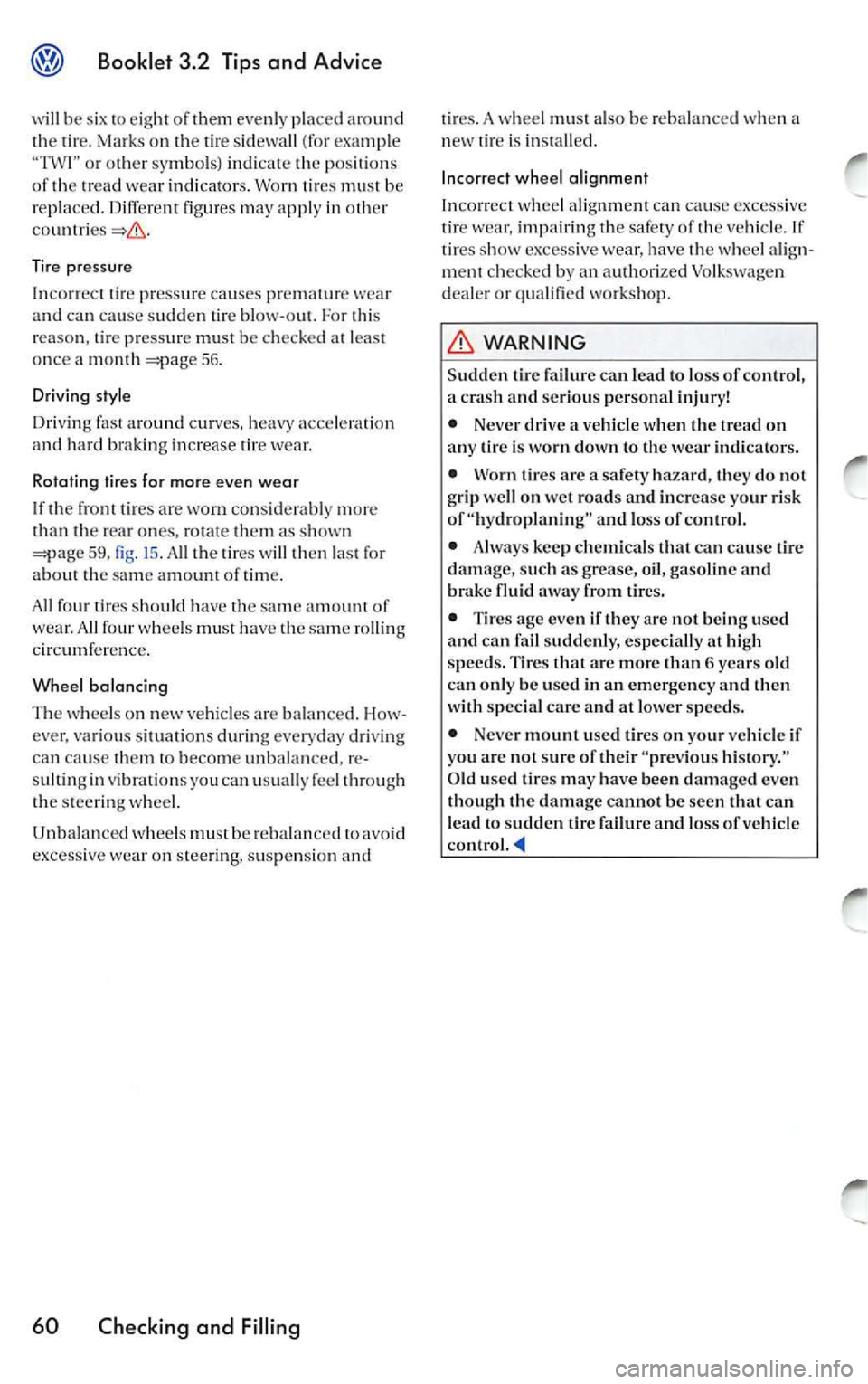
Booklet 3.2 Tips and Advice
will be s ix 10 eight of them evenly pla ced aroun d tire. Marks on the tire s idewa ll (fo r ex amp le o r oth er symbols) indicate the p ositions
of the tread w ear in dica tor s. Wo rn tires mu st be
rep laced . Different figu res may apply in oth er
Tir e pressure
In co rrec t lir e pr ess ure cause s pr ematur e wear
and can cause s udden tire blow -out. F or thi s
r easo n, tir e pressure must be c hec ke d at leas t
o nce a m ont h
56.
Driving style
Drivin g fast around cu rves, heavy acce lera tio n
and hard braking increase t ir e w ear.
Rotating tir es for more even wear
I f th e front tires are worn consid era bly m ore
than t he re ar ones, rotate th em as sh own
59, fig. 15 . All the tir es will then last for
about sa me of tim e.
A ll
tir es s hou ld have th e sam e am ount of
wear. All four w heels must have the sa me ro lling
ci rc umf ere nce.
Wheel balancing
Th e wh eels on ne w ve hicl es are balan ced. H ow
eve r. various situations during every d ay driv ing
can cause them
b ecom e unbalan ced, r e
s ultin g in vib rat io ns y ou can usuall y fe el throug h
th e steering wheel.
Unbalan ced w hee ls mu st be reb alan ced to avoid
e x cessive wear on stee ring, suspen sion and
60 Checking and Filling
tire s. A wheel also be rebalan ced w hen a
new lire i s in stalled .
In correct whee l alignment
Incorr ect whee l alignment can cause exc ess ive
ti re wea r, impa ir in g
safe ty of the ve hicle. If
t ir es s how excess ive wear, have wheel align
m en t ch ecke d by an authori zed Vol ksw age n
d ea le r or qualifi ed work sh op.
WARNING
Sud den tir e fa ilur e ca n le ad to lo ss of con trol ,
a cra sh and serious persona l injury!
• Neve r drive a vehicle wh en th e trea d on
any tire is wo rn dow n to the wea r indicator s.
• Worn tires a rc a sa fety hazar d, the y do not
gr ip we ll on wet roads and increase y our risk
of "h yd ropl anin g" and lo ss of contro l.
• Always kee p ch emi cals that can ca use tir e
d amage, s uch as g rease, oil , gaso line and
brak e fluid away from tire s.
• Tire s age even if th ey a rc not b ein g use d
and can fail sudd enl y, es pecially al high
s pe eds . Tir es that a re more than 6 year s old
can onl y be use d in an emergen cy and th en
w ith sp ecia l care a nd at lowe r sp eeds.
• Neve r mount u sed tire s on your vehicl e if
you a rc not sur e of their "pr ev iou s hi stor y."
Old use d tir es ma y ha ve been d amaged eve n
th ough the d am age ca nnot b e seen that can
lead t o sudd en tir e failure and loss of vehicle